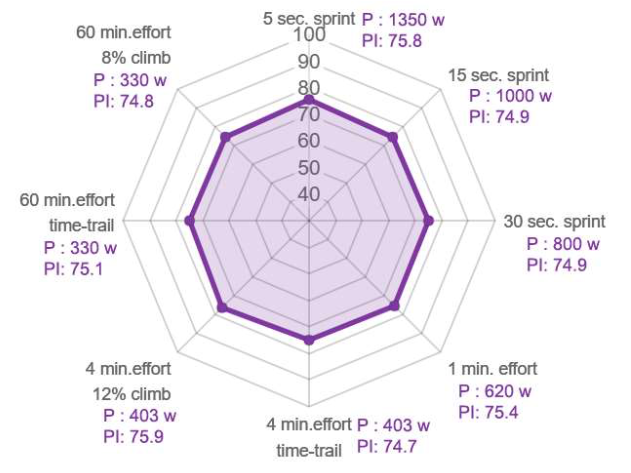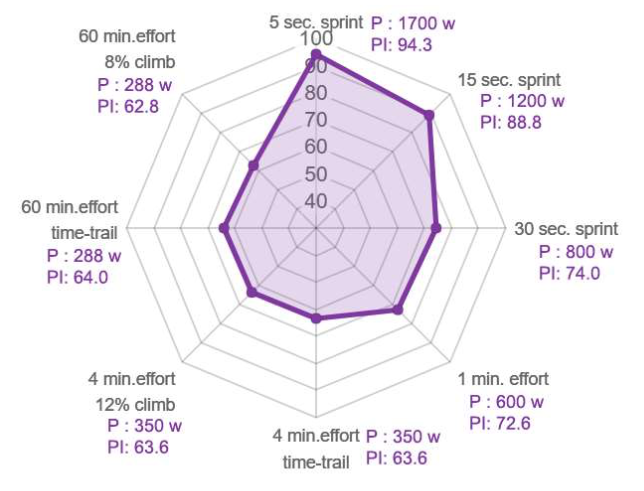Is the Power Speed Profile the next tool to replace FTP in mapping and tracking cycling performance?
It may very well be.
If you have ever done bike racing chances are you have experienced the shortcomings of threshold power.
Despite its focus among cyclists, anaerobic threshold or Functional Threshold Power far from always correlate with the podium at prize giving ceremonies.
A missing ingredient in predicting performance
Bike races are usually decided by one or more decisive moves. Be it the establishing of a break-away, a solo ride from out far or a bunch sprint for the line.
This is by no means new knowledge.
For more than a decade, Allen & Coggan’s power chart has provided a point of reference for necessary power to weight ratios across different durations and for riders at different performance levels (1).
Although straight forward power-to-weight based numbers are useful, they also have their weaknesses in predicting performance.
More specifically, they do not account for the significant impact of wind resistance when your ride at high speeds (2).
The relative power is a good predictor for performance uphill, but not for performance on a flat road.
Van Bon & Vroemen – Sportgericht, 2018
This is particularly the case if you are comparing your performance to that of riders of different height and weight.
What is the power speed profile?
The power speed profile (PSP) is a model for predicting cycling performance that also takes into account aerodynamic drag and different terrain types.
The concept was first introduced in a two-piece publication by the authors van Bon & Vroemen in 2018 (2-3). It was also presented at the Science & Cycling conference 2019 (4).
The power speed profile is based on:
- 8 different critical periods
- standardized aerodynamic drag estimates
- contrasting results to elite benchmark values
8 race deciding critical periods
Van Bon & Vroemen have defined eight critical periods. These constitute effort durations typically involved in race-deciding moves, like attacks and sprints of different lengths.
These include:
- 5 seconds
- 15 seconds
- 30 seconds
- 1 minute
- 4 minutes on time trial bike
- 4 minutes uphill (12% slope)
- 60 minutes on time trial bike
- 60 minutes uphill (8% slope)
The final score of your power profile test is then based on your predicted performance for each of the eight critical periods.
(Test protocol follows later in this text)
Aerodynamic drag estimates
In order to estimate your aerodynamic drag, the authors use your body weight and height in combination with a formula by Basset and colleagues, yielding the following coefficient of drag (Cd) times frontal area (A) (5):
- Time trial: CdA = 0,7 x A
- Road bike (hand in drops): CdA = 0,88 x A
This is a standardized formula that cannot take into account individual differences in riding styles and aerodynamic “skills” of riders of equal height and weight.
Instead, it allows for comparison between different riders given the premise that all riders are equally “skilled” at minimizing their aerodynamic drag.
Also, it makes for easy monitoring of progress for a single rider at different points in time.
Contrasting results with elite benchmark values
The power speed profile uses average speed from top riders as the benchmark for performance (2).
A top cyclist is defined as a specialist who excels at one or more critical periods.
Van Bon & Vroemen – Sportgericht 2018
The speed of top riders is calculated based on the highest power recordings available. The authors here drew upon the Allen & Coggan power chart, the UCI/WCC Power Profile Test and their own data from their own practice as coaches (1,6).
The speed of top riders are then used as the benchmark for each of the eight critical periods.
In practical terms, this gives you a comparison of how many watts you, given your height and weight, need to produce across 5 seconds, 15 seconds, 30 seconds etc. in order to match the speed of a top rider.
How do you test your power speed profile?
The testing to establish your power speed profile is based on two workouts. These are to be conducted at separate days.
The first workout includes the following 55 minute test protocol to assess your anaerobic capacity (2).
Anaerobic test: Warm-up (24 minutes)
The warm-up protocol consists of 10 shorter periods of progressively increasing intensity, starting at 40-50 percent of FTP.
Power then increases gradually up to 100% of FTP, including two 3-second all-out efforts.
Anaerobic test: Main set (24 minutes)
The main set consists of three sprints separates by easy riding:
- 6 second test – All-out effort, high resistance, start from standing still
- 6 minutes easy riding
- 30 second test – All-out effort, start with 60 RPM, RPM not higher than 140
- 15 minutes easy riding
- 60 second test – All-out effort, start with 60 RPM, RPM not higher than 140
The session is finally concluded with 8 minutes of easy riding at 40-50 percent of FTP.
The second workout includes a 60 minute protocol to assess your aerobic capacity (2). The authors suggest at least one day of recovery between the two tests.
Aerobic test: Warm-up (18 minutes)
The warm-up protocol consists of 6 steps starting at 40-50 percent of FTP and increasing gradually up to a 2 minute effort at 100 percent of FTP.
The warm-up is concluded by 6 minutes at 40-50 percent of FTP before the main set kicks off.
Aerobic test: Main set (34 minutes)
The main set consists of two all-out efforts separated by a 10 minute recovery period:
- 4 minutes test – All-out effort. Try to ride with an even pace.
- 10 minutes easy riding
- 20 minutes test – All-out effort. Try to ride with an even pace.
The aerobic test protocol is concluded with an initial 8 minutes of easy riding to cool down.
Your results from the 4 and 20 minute test are used to calculate your predicted result for 60 minute efforts (uphill and TT). This calculation is based on the Monod Critical Power method (7).
Interpreting your performance index
The results from your anaerobic and aerobic assessment forms the basis of your performance index.
This is where the power speed profile really becomes useful.
The way this works is by taking your power records for a given period and dividing it by the benchmark power of a top cyclist times 100.
Example: If your 1 minute power recording was 8.0 W/kg and the top cyclist benchmark is 10.5 W/kg your performance index will be:
Performance index: 8.0 / 10.5 x 100 = 76.2
Basically, the top rider benchmark for each critical period will always be 100.


Your performance index for each critical period will then help you decide where your strengths and weaknesses are. This can then be used to plan your strategy for up-coming races, as well as targeting areas for developing through your training.
How strong are successful riders?
It is worth noting that the benchmark value of 100 are based on the highest recorded power values obtained.
That is not to say that a performance index of 100 is necessary to become successful in races.
Van Bon & Vroemen provides an interesting example in this regard.
The authors point to a claim by Allen & Coggan suggesting a professional cyclist must have an FTP of at least 5.15 W/kg just to stay in the game throughout a race (2).
When this is converted via the power speed profile model the 5.15 W/kg FTP yields a performance index for 60 minute tempo of 81.1.
However, the authors highlight that data from Vroemen suggest some Continental (professional) riders are very successful in racing do not have a higher performance index than 74 (2).
In other words, they achieve race success with an FTP far lower than 5.15 W/kg.
This once again demonstrates that FTP is not the only determiner of success in cycling. The ability to generate a lot of power during the short and medium critical periods during a race are the real ‘weapons’, especially in the ‘classic’ cycle races.
Van Bon & Vroemen – Sportgericht 2018
According to Van Bon & Vroemen, the competitiveness of a pro-tour rider will qualify as “very good to exceptional” when scoring a PI of 90-100. Whereas a PI of 80-90 will label the same rider as “good”.
The PI of pro-tour riders:
- PI 90-100: Very good to exceptional
- PI 80-90: Good
- PI 70-80: Moderate to fair
For elite riders on the step below pro-tour, their competitiveness in their peloton differs for the similar PI values.
The PI of elite riders:
- PI 90-100: Exceptional
- PI 80-90: Good to very good
- PI 70-80: Moderate
The same goes for ameteur and master riders.
The PI of amateur and master riders:
- PI 80-100: Exceptional
- PI 70-80: Good to very good
- PI 60-70: Moderate to good
Some thoughts on the power speed profile
Personally, I think these two publications may carry great value to elite as well as amateur riders.
The addition of correcting power to weight ratios for aerodynamic drag adds, in my opinion allows for a more refined prediction of real life performance.
Furthermore, the benchmark values provides up and coming riders an enhanced point of reference for what is required to produce world class performances on the bike.
Most seasoned riders already have a subjective idea of where their strengths and weaknesses lie. The power speed profile makes it easy to identify these areas more precisely, as well as tracking your progress.
Granted, the model is not entirely without flaws. The authors themselves point to the compromise in not taking into account the standing position in climbing hills, as well as using standardized drag coefficients.
Secondly, if there is one thing I am missing, it is the ability to track sub-maximal performance, like aerobic power (power at VT1).
However, no model can ever be perfect. In the big scheme of things, I believe the power speed profile looks really interesting.
Also, the Van Bon & Vroemen deserves recognition for making this work openly accessible. Not to mention their online calculator that does all the heavy lifting in interpreting your results (link follows in summary section).
Take-home message
The power speed profile appears to be an exciting new tool that expands upon previous methods of predicting performance.
Here is a brief summary of the steps to determine your power speed profile and performance index:
1 | Download the test protocols for either Garmin or Zwift. Or enter the test protocols into your computer/trainer system manually.
2 | Perform test protocol 1 and 2 with at least one day of recovery between.
3 | Enter your results into the calculator at powerspeedprofile.com to produce your profile and performance index.
4 | Re-test your results every 2-4 months to track your progress and evaluate the effect of your training
Big shout out to photographer Jimmy Hansen for providing me with a banger of a featured photo. IG: @mrjimmyhansen
References:
- Allen H & Coggan AR (2006). Training and racing with a power meter. Velopress.
- Van Bon M & Vroemen G. Power speed profile: Performance model for road cycling (2). Sportgericht, 2018;6:2-8
- Van Bon M & Vroemen G. Power speed profile: Performance model for road cycling (1). Sportgericht, 2018;6:8-15
- Van Bon M & Vroemen G. Science & Cycling Conference 2019: Presentation Power Speed Profile: a Performance Model for Road Cycling.
- Bassett JD et al. Comparing cycling world hour records, 1967-1996: modeling with empirical data. Medicine & Science in Sports & Exercise, 1999;31(11):1665-1676.
- UCI/WCC Power Profile Test (n.d.). Retrieved from: https://cdn.wattbike.com/uploads/uk/docs/UCI-power-profile-test.pdf
- Tanner R & Gore C (2012). Physiological tests for elite athletes (2nd edition). Human Kinetics.
